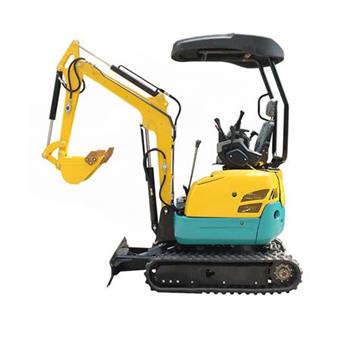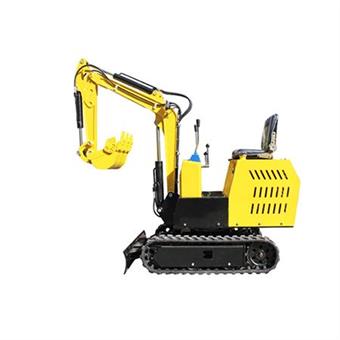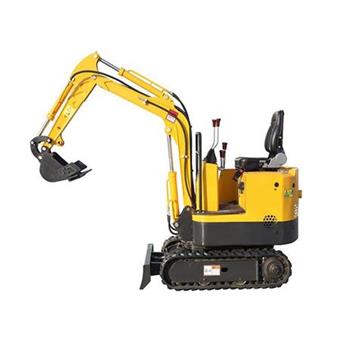
Notícias
Excavators are a cornerstone of the construction, demolition, and landscaping industries. When it comes to machinery that balances power with maneuverability, the 5-ton excavator is a popular choice among contractors and operators alike. This post provides an in-depth look into the dimensions, features, and applications of a 5-ton excavator. Whether you’re a seasoned professional or new to the industry, understanding the size and specifications of this equipment will help you make informed decisions for your projects.

As the name suggests, a 5-ton excavator weighs around five tons. These compact machines are designed for efficiency and versatility in confined spaces where larger equipment would struggle to maneuver. Despite their moderate size, 5-ton excavators are equipped with robust hydraulic systems and powerful engines, making them capable of handling various tasks such as digging, trenching, and demolition work.
Design compacto: Ideal for urban construction sites and areas with limited access.
Enhanced Mobility: A smaller footprint allows for quicker movement between tasks.
Versatilidade: Equipped with interchangeable attachments to perform multiple functions.
Eficiência de combustível: Often more economical to operate than larger excavators.
Understanding the physical dimensions of a 5-ton excavator is crucial for planning and execution on site. Although variations exist depending on the manufacturer and model, here are some typical dimensions:
Peso: Approximately 10,000 to 11,000 pounds (5 tons).
Length: Generally around 15 to 18 feet, depending on the arm’s extension.
Width: Roughly 5 to 7 feet, making it highly maneuverable.
Height: Typically between 7 to 9 feet, ensuring it can work under various overhead conditions.
These measurements may vary slightly with additional features such as cab size or specific attachments. The compact size does not diminish the power output, as these machines are designed to provide ample digging depth and operational reach while remaining agile.
When discussing “how big” a 5-ton excavator is, it is important to consider both its physical footprint and its operational capabilities. Physically, these machines are smaller than their larger counterparts, which often exceed 20 tons in weight. However, the engineering behind a 5-ton excavator allows it to perform heavy-duty tasks with precision.
Due to its limited size, a 5-ton excavator can easily operate in restricted spaces, such as:
Urban construction sites with tight corridors.
Residential demolition where space is limited.
Landscaping projects in smaller yards or parks.
Despite its smaller size, this excavator type can achieve impressive results:
Digging Depth: Many models can dig to depths sufficient for utility installations or foundation work.
Reach: The design of the arm and bucket ensures an extended operational range without sacrificing stability.
Estabilidade: A well-balanced machine that minimizes the risk of tipping even on uneven terrain.
A 5-ton excavator is invaluable for construction projects. Its compact size allows it to work in urban environments where space is at a premium, yet its digging power makes it ideal for laying foundations, trenching for utilities, and even minor demolition.
Demolition projects require precision, and a 5-ton excavator's compact design ensures that it can navigate confined areas safely. With a range of attachments, operators can efficiently tear down structures or remove debris without damaging the surrounding area.
Landscaping projects often involve tasks that require careful excavation and grading. The size of a 5-ton excavator makes it perfect for delicate work around trees, landscaping features, and agricultural structures where a larger machine might cause unintended damage.
Installing underground utilities, such as water or gas lines, requires a machine that can operate in narrow spaces while providing sufficient power for digging. The 5-ton excavator meets these needs while offering efficiency and reliability.
Understanding the detailed specifications of a 5-ton excavator can help potential buyers or renters decide if this machine fits their project requirements. Here are some essential specs to consider:
Potência do motor: Typically ranges from 50 to 70 horsepower, depending on the model.
Bucket Capacity: Usually between 0.2 to 0.5 cubic yards, ideal for smaller-scale operations.
Operating Weight: Around 10,000 to 11,000 pounds, ensuring stability and maneuverability.
Sistema hidráulico: Advanced hydraulic technology for efficient operation and quick response times.
Undercarriage: Designed for durability and smooth operation on various terrains.
These specifications ensure that the 5-ton excavator is not only compact but also powerful enough to handle a variety of tasks with precision and efficiency.
The versatility of the 5-ton excavator makes it suitable for a wide range of applications. Below are some of the most common uses:
Ideal for trenching, digging foundations, and creating basements. Its compact size allows for close-quarters work while maintaining a high level of performance.
Perfect for breaking down small structures or recycling materials on site. With the appropriate attachments, it can safely dismantle walls and other structures.
Used in landscaping to shape the land, grade surfaces, and prepare sites for further construction. Its precision makes it a favorite for delicate projects where larger equipment might cause damage.
Essential for digging trenches for cables, pipes, or other utilities. Its ability to navigate narrow spaces while delivering strong performance makes it indispensable in urban utility installations.
Employed in road construction and maintenance, especially for minor repairs and trenching. The 5-ton excavator’s efficiency helps reduce downtime and operational costs.
One of the biggest advantages of a 5-ton excavator is its maneuverability. Its compact size means it can access areas that larger machines simply cannot, making it perfect for urban or indoor applications.
These machines are designed to be fuel efficient. Their smaller engines consume less fuel compared to larger models, reducing operational costs and environmental impact.
Operating heavy machinery always requires strict adherence to safety protocols. Ensure operators are trained and that the machine is regularly maintained. Safety features such as emergency shut-off systems and stable undercarriages are integral to safe operations.
Regular maintenance is crucial for optimal performance. This includes checking hydraulic fluids, engine oil, and the undercarriage. Routine inspections can help prevent breakdowns and prolong the life of the excavator.
When comparing a 5-ton excavator with larger or smaller machines, several factors come into play:
While larger excavators offer more power and deeper digging capabilities, they often lack the versatility and maneuverability of the 5-ton models. Conversely, smaller excavators maybe even more agile but can fall short in terms of strength and operational capacity.
A 5-ton excavator strikes a balance between cost and performance. It is generally more affordable than larger models, both in terms of purchase price and operating costs. This makes it an attractive option for small to medium-sized projects.
5-Ton Excavator: Best suited for urban construction, landscaping, and utility work.
Larger Excavators: Better for major construction projects, deep excavations, and heavy demolition.
Smaller Excavators: Ideal for very tight spaces but with limited digging capacity.
A 5-ton excavator is mainly used for digging, trenching, demolition, landscaping, and utility installation tasks due to its compact size and versatile functionality.
While a 5-ton excavator is less powerful than larger models, its compact design offers superior maneuverability and efficiency in confined spaces, making it ideal for urban and small-scale projects.
Common attachments include various buckets, hydraulic breakers, grapples, and augers. These attachments allow the machine to perform multiple tasks such as digging, breaking, and lifting.
Regular maintenance includes checking hydraulic systems, engine oil, and the undercarriage. Routine inspections and timely servicing are essential for maintaining optimal performance and longevity.
Absolutely. Its compact design and high maneuverability make it especially suitable for urban construction where space is limited and precision is critical.



